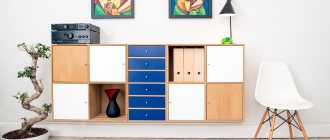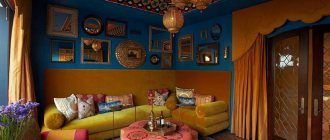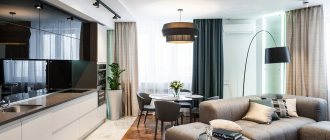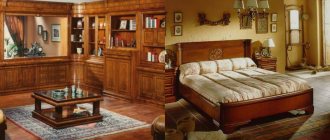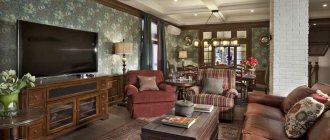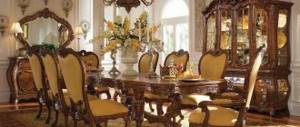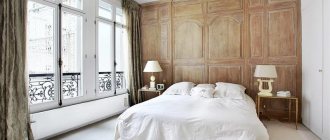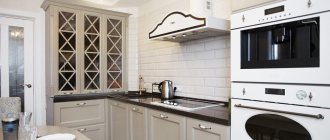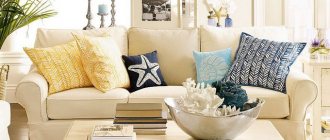The Egyptian style appeared about six thousand years ago. It is believed that it was this direction in design that became fundamental in the development of the European direction. The huge number of variations of the style is due to its centuries-old history. Over time, the aesthetics of the “land of the Nile and the sun” have not become less popular. And now, among fans of the East, and in particular Egyptian themes, you can meet people who have furnished their homes in this direction.
Laconic forms and luxurious decoration are dictated by history: in ancient times, this is how rooms for high-ranking persons and pharaohs were decorated. Hence the requests for large space: in small-sized housing, the Egyptian style will look ridiculous. However, you can integrate it with others, for example, with Art Deco or Art Nouveau elements.
Features of the Egyptian style
The main features of the style have undergone relatively few changes throughout history; of course, the materials for its creation have become more practical and accessible, and the aesthetics themselves have become softer and more comfortable.
Character traits
It is unlikely that it will be possible to copy the majestic decoration of the palaces of the pharaohs and the rich decoration of the tombs exactly. And, as a rule, when talking about the style of the Egyptians, we are talking about stylization or borrowing of individual motifs.
The characteristic and unchanging features of the style include:
- The use of geometric patterns, frescoes, ornaments and other decorations of the Egyptian style.
- The presence of columns, arches, niches.
- Minimal use of furniture.
- Use of high-quality and rare precious materials (ivory, malachite, turquoise, lapis lazuli and others).
- The presence of symbolic details: the sun, lotus, sphinx, pyramids, cats and others, in any design from wall decoration to decorative details.
The interior, from decoration to the smallest decorative elements, should have an atmosphere of luxury, abundance and grandeur.
Color palette and patterns
The color range includes all shades of golden color:
- sand,
- beige,
- ocher,
- Ivory.
These tones contain the color of sand, sun and heat that prevails in Egypt. In addition, the beliefs of the Egyptians - sun worship - are reflected here. The use of blue symbolizes the Nile River, the fertile nurse of the ancient Egyptians. To add harmony to the blue color, green is added, which together create bright accents.
The limited number of colors used - red, orange, blue, brown, black - is due to the fact that ancient man had only natural dyes that cannot be mixed.
One of the main features of the style is geometric patterns: stripes, meanders, enclosed in regular squares, patterned lines. This ornament sets the tone for the organization of the entire interior: the space is clearly divided into equal sections.
The ornament often contains hieroglyphs and images of plants (aloe, reed, papyrus, lily) and animals (falcon, goose, monkey, heron, fish, snake, crocodile).
Early period of development
The development of ancient Egyptian art is associated with the influence of the Roman people. Cleopatra's relationship with Caesar, her life in Rome, as well as the Last War of the Roman Republic and the conquest of Egypt, all of these factors had a powerful influence on the architecture of Roman Egypt. Today it is no secret that ancient Egyptian art impressed the Romans, no matter how alien it was to them. The triumphalism and majesty of Augustan classicism smoothly combined with the forms of Egyptian art. In addition, mysterious cults, including Egyptian ones, actively penetrated into Rome from the East.
Finished works on a similar topic
- Coursework Egyptian style 460 rub.
- Abstract Egyptian style 280 rub.
- Test paper Egyptian style 190 rub.
Receive completed work or specialist advice on your educational project Find out the cost
It is known that on the Campus Martius in Rome in 43 BC the temple of Isis and the serapeum-temple of Serapis were erected. These structures were surrounded by walls decorated with statues and obelisks. The third largest district of Rome even had a name translated from Latin meaning “in honor of Serapis.” Villa Adriana also absorbed clear signs of the influence of Serapis, because statues were brought there from the city of Canoba.
Figure 2. Pyramid of Cestius. Author24 - online exchange of student work
It must be said that the Romans in those days had the custom of exporting Egyptian statues and obelisks to their homeland and decorating their cities with them. Several obelisks have survived to this day on Roman streets (only 8 of them are genuine, the rest are imitative). And on Capitol Hill there were Egyptian figures of lions made of black basalt; later they were transported to the foot of the Capitol Stairs.
Too lazy to read?
Ask a question to the experts and get an answer within 15 minutes!
Ask a Question
Egyptomania is also noted in the architecture of buildings being built from scratch in Rome. A striking example illustrating this is the Pyramid of Cestius. It is noteworthy that the proportions of the erected structure demonstrated a lack of understanding by local architects of the principle of construction of real pyramids. Clear features of the Egyptian style were demonstrated by the Third Style of Ancient Roman painting. It combines the properties of ornamentation and Egyptian principles of pattern construction.
Byzantine sources from the 5th century AD also show signs of an Egyptianizing style in architecture, but these were probably some kind of Hellenistic manifestation.
Interior decoration
When recreating a style in a modern interior, you must be extremely attentive to the details of decoration, selection of furniture and decorations, which differ significantly from elements of other styles.
Finishing
The ceiling can be suspended, suspended or painted. You can paint it to match the walls, or in a more saturated color, but in no case lighter. An excellent solution would be to imitate the starry sky.
Ceramic is perfect for flooring. To add more luxury, canopies, reed mats, Egyptian-inspired bedspreads and animal skins are added.
When painting the floor and ceiling, you should adhere to strict symmetry. With the help of auxiliary attributes (vases, bowls, lamps) placed in certain places, you can enhance the sense of symmetry.
The walls in the apartment are plastered in light shades, and marble or granite slabs are also used for decoration. Also, the vertical surfaces of the room can be decorated with wallpaper imitating papyrus or straw, or photo wallpaper depicting walls dotted with hieroglyphs. It is important to alternate plastered walls and surfaces with stucco, bas-reliefs, niches and frescoes.
Between the walls and ceiling there may be borders decorated with stripes, frescoes or bas-reliefs. They must wear images of lotus leaves, papyrus, palm trees, people, arrows imitating the sun's rays or pictographic elements.
Furniture
The main qualities of furniture: weight and massiveness, combined with simplicity and functionality.
Main attributes:
- massive wide bed;
- wicker sofas, loungers;
- stable, leather-upholstered chairs;
- unusual stools.
The furniture, despite its massiveness, is not devoid of decorative elements. Legs in the shape of animal paws, chests and chests of drawers painted with gold, tables with glass tops, ivory inserts everywhere, gilding and relief carvings based on myths. As a rule, such delicate work is done to order.
Dark woods, willow, bamboo, and forged elements are ideal as materials for making furniture. Don't forget about jewelry made of precious metals and ivory.
The palace origin of the style implies maximum space, so the amount of furniture in the room should be minimized.
Windows, doors and lighting
If possible, the windows can be designed in the form of an arch. In an apartment, they should be draped with curtains. Variations of textiles are possible here: either plain or with the image of hieroglyphs. It depends on the style of the walls. If the color is monochromatic, then there may be an Egyptian-style ornament or pattern on the curtains.
Walls rich in ornamentation will go well with plain oriental-style curtains. When choosing a cornice, you should give preference to carved wooden cornices. You can assemble curtains using a bracelet decorated with semi-precious stones.
If sound insulation in an apartment is important, then you should install ordinary massive doors made of natural wood with a characteristic pattern or with a cemented relief. The shape of the opening can be made in the form of an arch. You can leave an open doorway, which will be quite consistent with the aesthetics of Egypt.
In ancient times, lighting was carried out through torches, which were the only sources of light. In a modern interior, they are replaced by various types of floor lamps; it is also possible to use sconces and chandeliers.
Jewelry, textiles and decor
The ethnic component of the style is emphasized by carefully selected decor.
Key decorative elements include:
- figurines and products made of ebony, depicting gods and animals;
- houseplants;
- painted frescoes;
- clay dishes;
- textiles made from natural materials (linen, cotton, fine wool);
- patterned columns.
The main thing in using details is to follow the laws of the culture of Egyptian civilization.
Interior of different rooms
When using a style in different rooms there are nuances.
Bedroom
A massive four-poster bed made of thick fabrics, lots of pillows in soft sand tones - what you need for the perfect bedroom.
Kitchen
Maximum light, play with space, spectacular textiles and the constant attributes of Egyptian aesthetics - all elements of style are perfectly combined in the kitchen.
Bathroom
There are legends about the baths of the pharaohs. Translated into modern realities, a bathroom made of natural stone, with exquisite bas-reliefs and marble tiles brings us closer to the luxury and grandeur of those ancient Egyptian baths.
Recommendations from professionals
When planning a design, you should not rely only on your knowledge and capabilities. For greater productivity and authenticity of the atmosphere, you should turn to the opinion of professionals.
Designers specializing in creating Egyptian interiors recommend:
- When purchasing souvenirs (figurines, papyrus, accessories), you need to get acquainted with their secret meaning. Each thing, according to the beliefs of the ancients, had its own properties and power.
- It is better not to use pieces of furniture that spoil the created atmosphere; for example, cabinets and cabinets should be abandoned in favor of chests made of natural materials.
- When creating an interior, you must be attentive to details and not reduce the entire interior to two or three style attributes, otherwise you will not be able to create a harmonious picture.
- A demonstration of luxury in the interior is required, otherwise there is a risk of recreating not a pharaonic palace, but a poor slave hut.
- Original arches, decorated recesses, and niches will bring mystery to the interior.
Experts say that if you rely on all of the above recommendations, you can recreate Egyptian aesthetics in the interior.
Finishing touch
Complete the decoration of your home with all kinds of Egyptian vases, masks, pyramids, carved wooden paintings, figurines of Egyptian mythology characters (both gods and sacred animals), painted papyri, busts of Cleopatra or Nefertiti, heads of pharaohs, earthenware dishes, hookahs - consider the whole variety of souvenirs from this hot country.
You can add a couple of rattan wicker items; they will organically complement the Egyptian style. Combine all the attributes used, try to create harmony. It is important to feel moderation, not to overdo it, without fanaticism and excesses.
Remember: one large statue of an Egyptian cat is better than twenty magnets on the refrigerator! Don’t turn your cozy home into a museum warehouse. Look for a balance of compositions, compile. The Egyptian style in the interior is not characterized by fussiness and pettiness.
Each Egyptian image, drawing, symbol was a carrier of a certain meaning, part of a sacred text or spell. Therefore, we do not recommend using Egyptian hieroglyphs without first inquiring about their meaning, even if you are inclined towards mysticism and consider yourself an expert in the occult.
For example, shabti figurines (shabtis or ushebtis), so popular among tourists, were created to accompany the deceased in the afterlife, and not as a variety of home exhibits. And on each of them is inscribed a unique spell, the meaning of which must be found out if you are unable to refuse to use them.
Use curvilinear patterns, the so-called “Babylons” and original cross-linear Egyptian patterns (pictured) to embody your decorative ideas in painting furniture or ceramics. They will demonstrate your deep knowledge and impeccable taste in creating an authentic Egyptian style for your home.
Below in the photo is the promised collection of authentic Egyptian ornaments.
The ancient Egyptians left grandiose buildings and large-scale sculptures to the fleeting, hustle and bustle of time, striking with the power and scope of creation for eternity. Imbue, recreate the greatness and grace of a largely lost and completely unknown, phenomenal civilization.
Author of the article Desssa
You might be interested in:
Indian style in the interior - in the chambers of the Maharaja Indian style in the interior is a motley mixture of bright colors and shiny gilding, an original combination of deliberate luxury and modest asceticism, simplicity...
Mexican style in the interior What is Mexican style design? Bright colors, an abundance of warm shades, Catholic crosses in the Spanish style, elaborate patterns and mysterious…
Loft style in the interior - an attic option for a modern apartment Loft is the closest “brother” of high-tech. These two styles are often confused because they are so similar: both promote a modern industrial style and “urban...
High-tech style in interior design - keeping up with the times High-tech style in interior design is one of the youngest postmodernist styles, which is sometimes called rationalism. The idea of style is an artistic interpretation...
